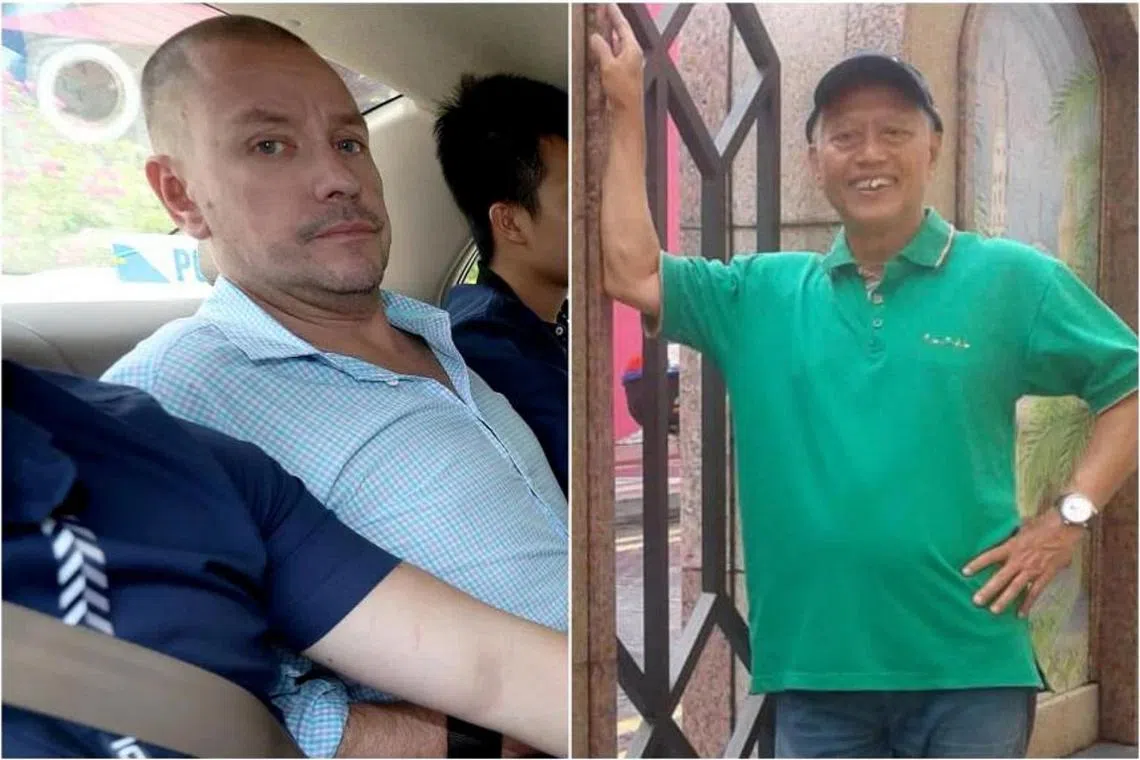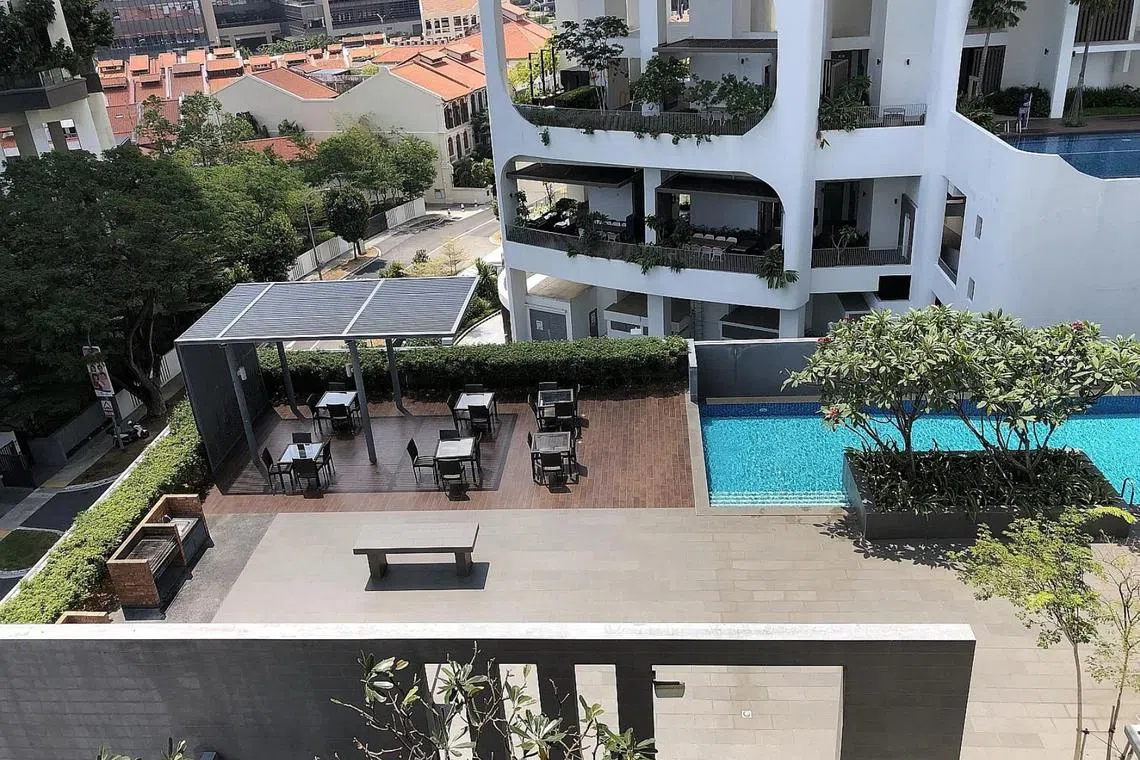Condo killer litter: Man who threw bottle that killed grandfather has jail term cut by 6 months
Sign up now: Get ST's newsletters delivered to your inbox

Andrew Gosling (left) had pleaded guilty in February this year to committing a rash act that led to Mr Nasiari Sunee’s death.
PHOTOS: ST FILE, NAS SURIATI NASIARI
Follow topic:
SINGAPORE - An Australian man who flung a wine bottle from the seventh storey of a condominium that hit a grandfather who later died had his jail term reduced on appeal.
Andrew Gosling, 50, had been sentenced to five years and six months’ jail on April 8
On Tuesday, Justice Chua Lee Ming said that looking at all the facts and circumstances of the case, the sentence should not exceed the maximum sentence for rash act causing death, which is five years.
He then cut Gosling’s sentence by six months.
Gosling had on Aug 18, 2019, flung a glass wine bottle from the seventh storey of Spottiswoode 18, in Tanjong Pagar
The bottle hit the head of delivery driver Nasiari Sunee, 73, a grandfather of nine, then hit the right shoulder of his wife, Madam Manisah Sitri, 69, whose right arm had to be in a sling for about two months.
Gosling pleaded guilty in February this year to committing a rash act that led to Mr Nasiari’s death.
He had also admitted to causing grievous hurt to Madam Manisah by rash act.
He was sentenced to four years’ jail for the rash act causing death charge, and 18 months for causing grievous hurt.
Principal District Judge Victor Yeo then ruled that the sentences for the two charges should run consecutively, for the total sentence to be five years and six months’ imprisonment.
On Tuesday, Gosling appeared before the High Court on video link with a shaved head.
His lawyers, Senior Counsel Sreenivasan Narayanan, Ms Gloria James and Mr Balamurugan Selvarajan, argued that Gosling’s sentence for the two charges he was convicted of should run concurrently instead of consecutively since the offences occurred as a result of a single act of throwing the bottle.
Mr Sreenivasan also said the sentencing judge must find justification for why the offence was not a single transaction. Or even if it was a single transaction, the judge must explain the reason for ignoring the single transaction rule.
The one transaction rule provides that when two or more offences are related, the punishment should form part of a single transaction so that the accused is not doubly punished for what is essentially the same conduct.

The barbecue pit area on level five of Spottiswoode 18 condominium, where Mr Nasiari Sunee was attending a party before being struck by a falling wine bottle on Aug 18.
PHOTO: COURTESY OF NAS SURIATI NASIARI
Deputy Public Prosecutor Ben Mathias Tan highlighted that the two victims represented separate legally protected interests.
He said: “When we look at the invasion of bodily interest, it is victim specific. The harm caused by the two offences is distinct, not part of the same unity.”
Mr Sreenivasan also took issue with the district judge failing to adequately consider the fact that two psychiatrists had said Gosling’s attack on the Malay-Muslim group was a result of his obsessive thoughts when he drank and did not convey his true feelings.
He said: “Each link of the chain is weak and yet the cumulative effect is a sentence that exceeded the maximum of the most serious charge.”
The DPP countered that Gosling acting after he voluntarily consumed excessive amounts of alcohol was an aggravating factor.
Mr Sreenivasan also argued it was not right for the district judge to apply the aggravating factors of religious hostility and intoxication twice for each offence as well as to justify the sentences running consecutively.
The DPP said the defence counsel arguing that one cannot apply the same aggravating factors to two offences is not the law. If this were the case, it would extend to accused individuals not being allowed to use the same mitigating factors for separate offences.
Justice Chua dismissed the defence’s argument that the one transaction rule should apply in this case. But he also disagreed with the prosecution’s point that it should not hold because there were two victims, since the two offences involved the invasion of the same legally protected interest – that of preventing rash acts that endanger human life.
Yet, he said: “It would be against common sense to say that he should be punished for the death or injuries caused to only one person, no matter how many persons were killed or injured by his act.”
In any case, the rule should not apply in cases where there is a need to give sufficient weight to deterrence to discourage such behaviour. It should also not apply if imposing the sentences consecutively would be in line with the gravity of the offences, added Justice Chua.
On whether the district judge failed to adequately consider the psychiatric report, Justice Chua said he had noted it in his judgment. He added: “This is an undisputed fact – the appellant’s conduct did demonstrate hostility towards Muslims.”
However, Justice Chua said that in applying the totality principle, which requires that the court take a last look at all the facts and circumstances to ensure that the sentence is sufficient and proportionate to the offender’s overall criminality, he would reduce the sentence.
Said Justice Chua: “In my view, on the present facts, the aggregate sentence ought not exceed the maximum provided for under (causing death by rash or negligent act).”
Since Gosling has been remanded since August 2019, The Straits Times understands that he will be released around Dec 30.


